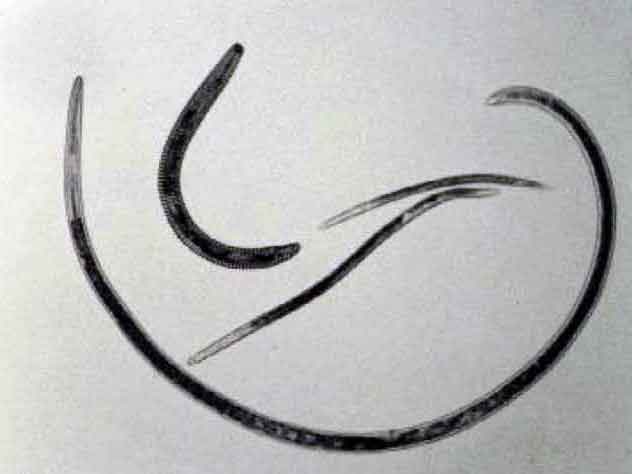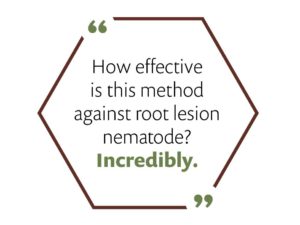
The agriculture industry often has adversaries, whether they’re pests, diseases, inclement weather, or various regulations. On the flip side, it seems that every year the industry takes progressive steps to effectively handle or work within all those constraints.
The problem with nematodes in the soil is no exception, and farmers and researchers work together to battle these parasites.
Nematodes in the Orchard: A Brief
There are thousands of species of nematodes, existing in nearly every ecosystem reaching from the tropics to Antarctica. These microscopic roundworms exist in beneficial and harmful varieties, with the plant-parasitic nematodes being a significant concern to the farming of crops.
Plant-parasitic nematodes can be migratory or sedentary, and can feed from inside (endoparasite) or outside (ectoparasite) a plant’s roots. There are a few that have drawn particular attention from the nut crop farming sector for their damaging effects on orchards.
All these plant feeders use a stylet—a syringe-like mouth spear—to penetrate root tissues.
Currently, the root lesion nematode receives particular attention because of its damage potential. This nematode is a migratory endoparasite that can feed on a plant root from the outside, but burrows into the roots to feed and lay eggs inside the root tissue. This causes considerable damage to a variety of crops, including almonds and, especially, walnuts.
The ring nematode is an ectoparasite and feeds on small roots or root hairs of the tree. It inhibits tree growth by syphoning nutrients from the roots, thus causing the roots to collapse, and creating a greater challenge for the tree to take up water and nutrients. This nematode is also infamous for increasing the incidence of bacterial blast and bacterial canker in Prunus plants, such as almond and stone fruit.
Root-knot nematodes have a range of hosts on which they feed, which increases complications for rotation crops. Sedentary feeders, these endoparasites cause the tree to produce large, easily visible galls on the roots and deprive a tree of vital nutrients.
Since certain species of nematodes are no strangers to California, many current almond rootstocks are resistant to the pests that have been known to be in the area for some time. However, the recent find of a species previously known only in Florida—the peach root-knot nematode—causes concern, as researchers do not yet know how widespread the nematode is, nor the challenges it may create in the production of high-value crops.
While no orchard or crop can definitively eradicate nematodes at this point, there are practices and chemical applications that can help with nematode management in both the pre- and post-planting stages of your perennial crops.
Mitigate the Risk
There is one rule above all others when it comes to planting your fields and orchards: Know your soil.
This includes the history of the field where you intend to plant. Knowing what grew in that space before the new crop can be a guide as to the numbers and species of nematodes expected to be present in the soil. For example, if a field previously had grapes and is being replanted to a perennial tree crop, it’s possible that the grapes left behind root-knot nematode populations that can damage certain nut crops. The same can be true if planting from one tree crop to a different tree crop. Odds are high that damaging nematodes are present in the soil, and possibly detrimental to the growth of highly sensitive and susceptible young trees.
A way to gauge the risk is through sampling. Root sampling and soil sampling are extremely important when planning the removal of an old orchard and replanting it with new trees. These samples help to identify not only the species, but also the number of nematodes present. This information can be particularly helpful when deciding which crop to plant next, or in the selection of a rootstock that best fits your soil conditions, as some rootstocks may be tolerant or resistant to a particular nematode found in the samples.
Ways to combat nematodes include fumigant and non-fumigant nematicides. Each has its strengths, weaknesses, and challenges.
How Nematicides Measure Up
Soil fumigant nematicides are currently a highly effective tool to combat the parasites. After the phase-out of methyl bromide for commercial orchard preparation in 2005, 1,3-D-containing compounds are now widely used, sometimes in mixtures with chloropicrin. These work well at the right soil moisture and temperature conditions, and can almost eliminate nematodes. When solidly treating the orchard ground, nematode suppression can last several years, which can protect the trees and allow for vigorous establishment. If using spot or strip application, suppression is shortened to up to a few months.
Novel chemical nematicides are currently in different stages of development. These are non-fumigants, and therefore cannot redistribute as gas in the soil, and need to be delivered to the site of action. This is most effectively done by soil drenches through irrigation water.
The nematology group at the Kearney Research and Extension Center, led by Dr. Andreas Westphal, has an active program on nematode management in perennial crops. Initially geared towards the regulated nursery industry, this team conducted a series of studies that investigated the efficacy of novel nematicides. They measured plant growth relative to possible fumigants, a comparison of nematicides, and the use of non-fumigant methods. Before conducting the experiments, each of these studies measured the number of nematodes present at each one-foot increment in depth, as some nematodes are found at specific depths (and some are found at all depths).
In studies conducted with nematicides using microplots, fumigated soils produced more plant growth than non-fumigated soils.
These microplots—measuring two feet in diameter, five feet deep—contained soils of different textures and nematode infestations, and were treated by drench application of the novel nematicides. After assessing the suppression of the root nematode, all the plots were planted to the same rootstock. Plant growth was monitored, as was the root populations of the nematode, to measure the effects of using nematicides versus not, as well as compare nematicides against one another.
The conclusion thus far: not all nematicides are created equal.
The levels of efficacy varied among materials, with some reducing the presence of nematodes nearly to zero, and others hardly showing any suppression when compared to the water control used in the experiment, creating a range of results from an equal range of materials.
One problem with fumigant use is that these chemicals are heavily restricted, and the needs of farms often exceed these restrictions. There are so-called “township caps,” which restrict how much material may be used in a certain area per year.
Biorational Solutions
Biorational methods utilize natural products or processes for nematode suppression, which can make them less stringently regulated than their chemical equivalents. Experiments continue to explore the use of fumigant alternatives.
One such experiment, in cooperation with the United States Department of Agriculture’s Agricultural Research Service (USDA/ARS) researchers Dan Kluepful and Greg Browne, explored the concept of anaerobic soil disinfestation (ASD) in terms of eliminating root lesion nematodes.
Treatments were initiated after determining nematode population densities. Different organic substrates—such as tomato pomace, rice bran, molasses, and others—were incorporated into the soil at about nine tons of substrate per acre. Drip irrigation lines were placed before the soil was covered with plastic film for about one month in order to prevent the diffusion of oxygen. The plots were then heavily irrigated, and kept moist for the month the plastic was laid down.
The prevention of the diffusion of oxygen, coupled with the activity of soil microbes that exist in such a harsh and oxygen-deprived environment, are what create anaerobic conditions in the soil. While it’s not fully understood what kills the nematodes, in addition to the anoxic conditions, these microbes decompose the organic substrate, and as a byproduct, produce substances that may be toxic to nematodes.

After planting, nematode populations were measured once again. The numbers showed that the presence of nematodes in the soil was incredibly low. So low, in fact, that the results were similar to the top-rated fumigant.
Riding on the tails of this success, more research is being conducted to determine the best time of application, as well as other protocol specifics. The limitations have not yet been fully explored, and it is unknown whether or not it suppresses all species of nematodes the same or as effectively. There’s some indication that some species may be more difficult to manage.
When looking at the experiments collectively, the most impressive is ASD, because it proved to be as effective against some nematodes as fumigant alone. ASD, however, is logistically more challenging, currently quite expensive when compared to treatments using chemical fumigants, and still in need of protocol improvements.
Post-plant Predicament
There are currently only two post-plant registered nematicides. Post-plant applications are logistically feasible if an existing irrigation system can be used, and may reach cost-effective levels easier than the challenging pre-plant options. More research is needed to determine the ideal times for application.
There’s also the question of yield. When measuring walnut yield in one experiment in order to compare the treatments, there was no significant difference. In your own orchard, however, it’s important to wait until the second year after treatment to begin looking for differences in growth or yield. Since the best timing for application of nematicide is still being researched, and trees need time to recover from the root damage, measuring one year after treatment is too early to offer significant changes.
It’s very difficult to solve nematode problems in California, mainly due to high temperatures that promote nematode reproduction, soil types that facilitate nematode movement, and long cropping periods with the same host. Once a nematode problem is established, no choice of orchard or crop can eradicate the parasite. These practices and chemical applications can help with nematode management in both the pre- and post-planting stages of your perennial crops. Work is ongoing to find additional methods and solutions.










